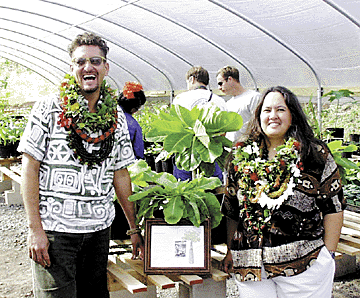



Office of Hawaiian Affairs
Winston Kauhane Morton and Roxanne Adams hope to
harvest both greater numbers of endangered Hawaiian plants
and greater success in agriculture among Hawaiians.
AS you drive down the dirt road into the Hooulu Mea Kanu project of the Office of Hawaiian Affairs, it is difficult to believe that you are five minutes away from Domino's Pizza and Foodland in the Laie Shopping Center. The little valley must look much as it did 200 years ago, except for the immaculate shade house and the portable office. Fertile soil for
Hawaiian projectThe project is run by Roxanne Adams and her assistant Winston Kauhane Morton, both alumni of the Waimea arboretum where they worked as plant propagators. Together, and without any other help, the two are running the new program, which in English means "to cause to grow."
On a double level, that is exactly what Adams and Morton are aiming to do. They are not only causing endangered Hawaiian plants to grow, but their other purpose is to create income growth among the Hawaiian people involved in Hooulu Mea Kanu.
"OHA took a survey and found a lot of interest in agriculture among Hawaiian people, particularly those on homestead lands. They wanted a better way to use the land they had and the low cost water they could irrigate with," Morton said.
"The project was set up to run on two islands -- Molokai and Oahu, and we will be starting a third in Hilo next week. We began on Molokai because OHA has a land base there, where it didn't on Oahu. We're leasing this land, we don't own it. The two programs have different purposes, but run the same way," Adams said. "The Molokai people are working on the restoration of Kahoolawe, the replanting of native species on the island. Here on Oahu, the focus is on raising plants to sell to the landscape industry and garden shops.
"We are teaching plant propagation, but we are also teaching small business practices so the participants can add to their income. We provide each of the 25 people in the program with three kits, each of 425 seedlings or rooted cuttings, along with the pots and the planting medium. Then they meet out here all day for 10 Saturdays and we teach them how to cultivate the plants. They take them to their own property, and we visit them each month to make sure the plants are up to market standards."
When the plants are of salable size, Hooulu Mea Kanu buys them from the grower and then markets them to commercial outlets. "We don't buy all of them, just 75 percent. We figure 5 percent will die and the other 20 percent they can use to propagate more plants," Adams said.
None of the endangered plants has been gathered from the wild, but come from Waimea arboretum which is licensed to sell them. Morton and Adams are most proud of their single specimen of Kokia cookei, a Molokai tree cotton that no longer exists in the wild. This specimen was grown from seed at Waimea and grafted to a less endangered Kokia kauaiensis. It was planted last week and the ti leaf lei circling the little plant in its fenced off corral is just beginning to dry out.
But their real purpose is not to cultivate the difficult native plants that require special care, but to grow the easy ones, the ones that sell at your garden shop. Growing finicky plants is like flossing your teeth or rotating your tires - it's a great idea, but such a nuisance. The big sellers are the ones that keep on growing.
Among the candidates Adams and Morton endorse is alula, a Brighamia with big, shiny bright green leaves that will grow well on an apartment lanai as well as in a garden. Another is manele, or soapberry tree. The fruit pulp contains a soaplike substance that forms a lather when mixed with water, and the seeds are used by lei makers.
They are cultivating lama trees for the Kahoolawe project, but are keeping some on Oahu for hula halau. The heartwood of the tree, which is part of the ebony family, is black. A cube of this black wood is swathed in yellow tapa and represents Laka, goddess of hula, and is treasured by the halau, Morton said.
In the shade house grow tiny seedlings of the endangered Abutilon sandwicense that will have green flowers. "The seeds had been stored for 20 years at Waimea," Morton said. "The plant they came from was a 1974 accession of the arboretum. It died, but somebody saved the seeds and then forgot about them. I soaked them in warm water, and they germinated. Never say never about Hawaiian plants."
"We've chosen plants that will be easy for the people in the program to grow," Adams said. "We want to make the first step as successful as possible and at the same time perpetuate these beautiful plants that an important part of the Hawaiian culture." Before long, you should find them at local garden shops.
Gardening Calendar in Do It Electric!
Send queries along with name and phone number to:
Evergreen by Lois Taylor, Honolulu Star-Bulletin, P.O. Box 3080, Honolulu 96802.
Or send e-mail to features@starbulletin.com.
Please be sure to include a phone number.
Evergreen by Lois Taylor is a regular Friday feature of the
Honolulu Star-Bulletin. © 1998 All rights reserved.